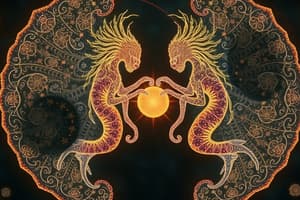Podcast
Questions and Answers
What is mitosis/meiosis? Describe the stages of mitosis/meiosis?
What is mitosis/meiosis? Describe the stages of mitosis/meiosis?
Mitosis and meiosis are both types of cell division, but they have different outcomes. Mitosis results in two daughter cells that are genetically identical to the parent cell. This process is used for growth and repair. Meiosis results in four daughter cells that are genetically different from the parent cell. This process is used for sexual reproduction. The stages of mitosis are prophase, metaphase, anaphase, and telophase. The stages of meiosis are prophase I, metaphase I, anaphase I, telophase I, prophase II, metaphase II, anaphase II, and telophase II.
DNA sequence that control traits are called?
DNA sequence that control traits are called?
- Proteins
- Genes (correct)
- Enzymes
- Characteristics
Meiosis is a type of cell division that will produce?
Meiosis is a type of cell division that will produce?
- Packets of pollen to be transferred between the abdomen of insects
- Exact copies of the parents cell
- The male and female sex cells (correct)
- 2 new somatic cells
During the process of _______, 2 daughter cells will be created with identical DNA.
During the process of _______, 2 daughter cells will be created with identical DNA.
When is DNA duplicated in germ line cells?
When is DNA duplicated in germ line cells?
During the process of _______, 4 daughter cells will be created with different DNA pattern.
During the process of _______, 4 daughter cells will be created with different DNA pattern.
How many chromosomes are found in the human body?
How many chromosomes are found in the human body?
How many chromosomes are found in human sex cell?
How many chromosomes are found in human sex cell?
Synapsis is the process whereby?
Synapsis is the process whereby?
Mitosis results in two _______ cells, while meiosis results in _______ haploid cells
Mitosis results in two _______ cells, while meiosis results in _______ haploid cells
In this phase the centrioles are at the opposite poles of the cells?
In this phase the centrioles are at the opposite poles of the cells?
What is the reason chromosomes condense into visible structures during mitosis and meiosis?
What is the reason chromosomes condense into visible structures during mitosis and meiosis?
Flashcards
Mitosis
Mitosis
A type of cell division resulting in two identical daughter cells with the same number and kind of chromosomes as the parent cell.
Meiosis
Meiosis
A special type of cell division creating four daughter cells with half the chromosome number of the parent cell.
Cell Cycle
Cell Cycle
The series of events a cell goes through as it grows and divides.
Interphase
Interphase
Signup and view all the flashcards
Prophase
Prophase
Signup and view all the flashcards
Prometaphase
Prometaphase
Signup and view all the flashcards
Metaphase
Metaphase
Signup and view all the flashcards
Anaphase
Anaphase
Signup and view all the flashcards
Telophase
Telophase
Signup and view all the flashcards
Cytokinesis
Cytokinesis
Signup and view all the flashcards
2n
2n
Signup and view all the flashcards
n
n
Signup and view all the flashcards
Crossing-over
Crossing-over
Signup and view all the flashcards
Chromosome
Chromosome
Signup and view all the flashcards
Sister chromatids
Sister chromatids
Signup and view all the flashcards
Homologous Chromosomes
Homologous Chromosomes
Signup and view all the flashcards
Gene
Gene
Signup and view all the flashcards
DNA Replication
DNA Replication
Signup and view all the flashcards
Spindle fibers
Spindle fibers
Signup and view all the flashcards
Centromere
Centromere
Signup and view all the flashcards
Kinetochore
Kinetochore
Signup and view all the flashcards
Gamete
Gamete
Signup and view all the flashcards
Equatorial Plate
Equatorial Plate
Signup and view all the flashcards
Meiosis I
Meiosis I
Signup and view all the flashcards
Meiosis II
Meiosis II
Signup and view all the flashcards
Study Notes
General Biology 1: Mitosis/Meiosis
- Mitosis and meiosis are types of cell division
- Mitosis produces two identical daughter cells, while meiosis produces four genetically different daughter cells
- Meiosis is a process of cell division that reduces the chromosome number by half, crucial for sexual reproduction
- The diploid number (2n) for the example given is 6
- DNA sequence that controls traits are called genes
- Meiosis produces packets of pollen for transfer between insects, male and female sex cells, and 2 new somatic cells
- DNA is duplicated in germ line cells during the S phase
Stages of Mitosis
- Prophase: Chromatin condenses into chromosomes; the nuclear membrane breaks down; spindle fibers form
- Prometaphase: Spindle fibers attach to kinetochores on chromosomes; chromosomes begin to move
- Metaphase: Chromosomes align at the metaphase plate
- Anaphase: Sister chromatids separate and move to opposite poles
- Telophase: Chromosomes decondense; nuclear membrane reforms; cytokinesis occurs
Stages of Meiosis I
- Prophase I: Homologous chromosomes pair up (synapsis); crossing-over occurs; nuclear membrane breaks down
- Metaphase I: Homologous chromosome pairs align at the metaphase plate
- Anaphase I: Homologous chromosomes separate and move to opposite poles
- Telophase I: Chromosomes arrive at the poles; nuclear membrane may reform; cytokinesis occurs.
Stages of Meiosis II
- Meiosis II essentially duplicates mitosis steps
- Prophase II: Chromosomes condense again; nuclear envelope breaks down; spindle fibers form.
- Metaphase II: Chromosomes align at the metaphase plate.
- Anaphase II: Sister chromatids separate and move to opposite poles.
- Telophase II: Chromosomes decondense; nuclear membrane reforms; cytokinesis occurs.
Chromosomes in Human Body
- Humans have 46 chromosomes in somatic cells (23 pairs)
Human Sex Cells
- Human sex cells (sperm and egg) have 23 chromosomes
Other Key Information
- Synapsis is the process of homologous chromosomes pairing up
- Crossing-over is the exchange of genetic material between homologous chromosomes
- The terms metaphase plate and equatorial plate are interchangeable during mitosis and meiosis
Studying That Suits You
Use AI to generate personalized quizzes and flashcards to suit your learning preferences.





